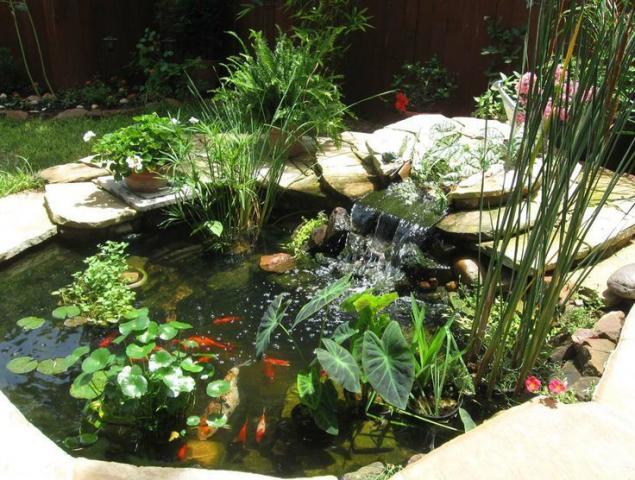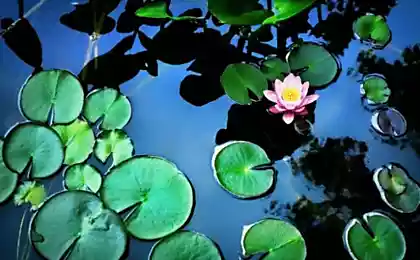983
Pond on your site: what plants to plant in the pond
Wonderful decoration, and sometimes even a real work of art garden pond help to make plants that are planted around him, as well as directly in the water.
To decorate the bodies of water and coastal zones are used plants such as irises, nymphs (or water lilies), daylilies, and reeds, and various herbs.

General recommendations:
Initially when planning space to better define the reservoir sunny plot. This is in order to prevent algal blooms.
When choosing the right place, care of plants in water is simple: you can see the overgrown grass and flowers in the current year
. Nymphs (water lilies and water lilies)
Some of the most beautiful plants for the pond. Nymphs are a variety of colors: white, pink, yellow, red and even purple and blue. The plant has a powerful rhizome and roots, which are mounted in the ground at the bottom of the pond and the water surface stretch long stems with flowers. Size flower nymphs varies from very small (dwarf water lilies) to medium and large and reach a diameter of 2 to 25 cm.
The store nymphs are sold in plastic boxes, in which plant roots are kept in water with a small amount of land. The box is 1-2 shoots. When planting the roots of the plants in this form should be immersed in water.
Depth of immersion in the water depends on the plant size: small nymphs sufficiently lowered to a depth of 30 cm, the average plant is best used in a pond with a depth of at least 60 cm Nymphaeum likes clean water, so you should regularly pond cleaning in combination with the use of special means of preserving the purity. water.
The colors of the nymphs can be admired in the period from June to September. One flower lily blooms on average 4-5 days: 8-10 am flower blooms, then around 16 o'clock closes and goes under the water. Nymphs should be planted with the onset of stable warm weather - from the end of May and continue throughout the summer. Although the cold summer weather Nymphaea, of course, will not die - it just will not bloom
.
Blooming Nymphaea 'James Brydon'
Withered petals, we recommend to remove, to prevent algal blooms in the pond. In winter, the nymphs should dig up and store in a box until spring. Plants can be stored in the cellar - they do not need light during winter
. Irises
Very beautiful perennial that thrives near water. There are about 200 varieties of irises, including swamp irises, which are well adapted to a lot of moisture.

For planting irises purchased as bulbs and bulbs with a stem. They should be planted, since the end of May and throughout the summer. As a suitable dressing fertilizer, which should be applied at planting in the spring, and 1-2 times during the first half of summer. Irises like moisture, so you need to ensure that in the pond was always water.
In winter, irises should cover. Roughly 1 every 4 years irises bulbs are dug in winter with a view to transplant.
For landing in the pond are also suitable such undemanding plants like daylilies, reeds, Piste, marsh crocus, loosestrife. On each of them we will tell a little bit more.

daylilies
Herbaceous perennial plant with red flowers. Well suited for the garden, as after flowering the leaves are beautiful. Daylilies thrive in shade and partial shade, but may well blossom in diffuse light. However, from experience, to avoid landing daylily in the sun that harm the flowers.
Daylilies are blooming about a month. They can be planted 2 times a year: at the end of spring (May) and late summer (August and September). The plant is well winters in the soil - it is not necessary to dig daylilies or transplanted
. Reed
Beautiful water-loving and undemanding plant that is also used in landscape design at the design of the reservoir. There are many types of canes, they all have an inflorescence at the top of the stem. Unlike daylily, cane loves the open sun. Saves decorative throughout the season, but the main flowering time - in June and July. Unpretentious to the soil and requires careful maintenance. It tolerates the winter in the ground, but in the autumn of dry leaves is recommended to cut.

Sedge
Decorative perennial herb. It grows well, and if necessary, you can limit its growth, dug into the soil a metal plate, or limiting the growth zone sedge gravel. Main usability of the plant - a great adaptation to the cold and temperate climate, unpretentiousness to the composition of the soil. Sedge plant can be during the summer period (as an option - in special containers), but cut off the dry leaves is recommended after a winter
. Piste
Green perennial plant native to the tropics, which grows directly in the water. As with all aquatic plants, likes plenty of light and warm water.
The plant is usually planted in shallow waters from the spring and throughout the summer period. Piste does not tolerate cold water and feels good in the water of 15 degrees. Subject to the conditions of temperature does not require special care.
Swamp
crocus Perennial flowering plant. She loves the sun, as the time to choose a landing in May and August. Despite the apparent fragility, crocus bulbs marsh good winter in the ground. The plant will add to your body of water colors and subtle beauty.

loosestrife
Perennial herb with purple and pink flowers. If you are planting loosestrife first time, the seedlings are planted at the beginning of its calendar year (January to March). Grown seedlings are planted in the ground, starting in May. In the first year the plant usually does not give flowers, but it has beautiful leaves that the autumn become red. Flowering loosestrife throughout the summer.
All of these plants do not require special care: it is necessary to remove dead leaves and, of course, to carry out regular watering.
To decorate the bodies of water and coastal zones are used plants such as irises, nymphs (or water lilies), daylilies, and reeds, and various herbs.

General recommendations:
Initially when planning space to better define the reservoir sunny plot. This is in order to prevent algal blooms.
When choosing the right place, care of plants in water is simple: you can see the overgrown grass and flowers in the current year
. Nymphs (water lilies and water lilies)
Some of the most beautiful plants for the pond. Nymphs are a variety of colors: white, pink, yellow, red and even purple and blue. The plant has a powerful rhizome and roots, which are mounted in the ground at the bottom of the pond and the water surface stretch long stems with flowers. Size flower nymphs varies from very small (dwarf water lilies) to medium and large and reach a diameter of 2 to 25 cm.
The store nymphs are sold in plastic boxes, in which plant roots are kept in water with a small amount of land. The box is 1-2 shoots. When planting the roots of the plants in this form should be immersed in water.
Depth of immersion in the water depends on the plant size: small nymphs sufficiently lowered to a depth of 30 cm, the average plant is best used in a pond with a depth of at least 60 cm Nymphaeum likes clean water, so you should regularly pond cleaning in combination with the use of special means of preserving the purity. water.
The colors of the nymphs can be admired in the period from June to September. One flower lily blooms on average 4-5 days: 8-10 am flower blooms, then around 16 o'clock closes and goes under the water. Nymphs should be planted with the onset of stable warm weather - from the end of May and continue throughout the summer. Although the cold summer weather Nymphaea, of course, will not die - it just will not bloom
.

Blooming Nymphaea 'James Brydon'
Withered petals, we recommend to remove, to prevent algal blooms in the pond. In winter, the nymphs should dig up and store in a box until spring. Plants can be stored in the cellar - they do not need light during winter
. Irises
Very beautiful perennial that thrives near water. There are about 200 varieties of irises, including swamp irises, which are well adapted to a lot of moisture.

For planting irises purchased as bulbs and bulbs with a stem. They should be planted, since the end of May and throughout the summer. As a suitable dressing fertilizer, which should be applied at planting in the spring, and 1-2 times during the first half of summer. Irises like moisture, so you need to ensure that in the pond was always water.
In winter, irises should cover. Roughly 1 every 4 years irises bulbs are dug in winter with a view to transplant.
For landing in the pond are also suitable such undemanding plants like daylilies, reeds, Piste, marsh crocus, loosestrife. On each of them we will tell a little bit more.

daylilies
Herbaceous perennial plant with red flowers. Well suited for the garden, as after flowering the leaves are beautiful. Daylilies thrive in shade and partial shade, but may well blossom in diffuse light. However, from experience, to avoid landing daylily in the sun that harm the flowers.
Daylilies are blooming about a month. They can be planted 2 times a year: at the end of spring (May) and late summer (August and September). The plant is well winters in the soil - it is not necessary to dig daylilies or transplanted
. Reed
Beautiful water-loving and undemanding plant that is also used in landscape design at the design of the reservoir. There are many types of canes, they all have an inflorescence at the top of the stem. Unlike daylily, cane loves the open sun. Saves decorative throughout the season, but the main flowering time - in June and July. Unpretentious to the soil and requires careful maintenance. It tolerates the winter in the ground, but in the autumn of dry leaves is recommended to cut.

Sedge
Decorative perennial herb. It grows well, and if necessary, you can limit its growth, dug into the soil a metal plate, or limiting the growth zone sedge gravel. Main usability of the plant - a great adaptation to the cold and temperate climate, unpretentiousness to the composition of the soil. Sedge plant can be during the summer period (as an option - in special containers), but cut off the dry leaves is recommended after a winter
. Piste
Green perennial plant native to the tropics, which grows directly in the water. As with all aquatic plants, likes plenty of light and warm water.
The plant is usually planted in shallow waters from the spring and throughout the summer period. Piste does not tolerate cold water and feels good in the water of 15 degrees. Subject to the conditions of temperature does not require special care.
Swamp
crocus Perennial flowering plant. She loves the sun, as the time to choose a landing in May and August. Despite the apparent fragility, crocus bulbs marsh good winter in the ground. The plant will add to your body of water colors and subtle beauty.

loosestrife
Perennial herb with purple and pink flowers. If you are planting loosestrife first time, the seedlings are planted at the beginning of its calendar year (January to March). Grown seedlings are planted in the ground, starting in May. In the first year the plant usually does not give flowers, but it has beautiful leaves that the autumn become red. Flowering loosestrife throughout the summer.
All of these plants do not require special care: it is necessary to remove dead leaves and, of course, to carry out regular watering.























